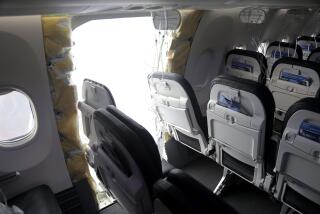Crew Account, Data in China Jet Plunge Differ
SAN FRANCISCO — Federal investigators said Friday that they were having trouble reconciling recorded flight data with crew accounts of the six-mile dive of a China Airlines jetliner over the Pacific Ocean.
“There are places where we are going to have some problem reconciling their recollection with the flight data,” said G. H. Bursley, a member of the National Transportation Safety Board.
Government investigators have been interviewing the crew of last Tuesday’s China Airlines 747 flight, hoping they could explain why the plane suddenly plunged 32,000 feet and came within seconds of crashing into the ocean.
Officials have been hampered by incomplete or non-existent data from the airliner’s digital flight data recorder and the cockpit voice recorder.
Automatic Pilot Question
Disclosed Friday was the latest contradiction between what officials have been able to learn from their preliminary analysis of the flight data and crew accounts of the accident.
The pilot has told investigators that he took the airliner off automatic pilot soon after the plane began to descend. But officials have not been able to confirm it by preliminary analysis of flight data.
The incident happened 300 miles west of San Francisco on Tuesday, injuring 55 of the 268 people on board. The Boeing 747, on a flight from Taipei, Taiwan, to Los Angeles, dropped from 41,000 to 9,000 feet in less than two minutes.
The pilot pulled the craft from its dive about 36 seconds before it would have hit the water. The plane made an emergency landing at San Francisco International Airport.
A Critical Question
The automatic pilot system keeps the plane at specified elevations and speed, making the issue of whether it was ever turned off--and when--possibly crucial.
When the No. 4 engine of the Boeing jet burned out, the automatic pilot would have made an attempt to keep the plane at its programmed elevation, officials said.
The loss of power and the opposing workings of the automatic pilot could have caused the plane to descend with its nose up, forcing it into a midair roll and a dive, officials said.
Under proper emergency procedures, the pilot should have taken the plane off automatic pilot.
Bursley has said investigators have narrowed the possible causes of the 32,000-foot plummet to either mechanical failure by the aircraft or procedural error by a crew member.
Crew Blamed Turbulence
During early stages of the investigation, the crew said turbulence caused the No. 4 engine to stall and forced the plane into a sharp right-bank dive.
But Bursely said that a preliminary analysis of the plane’s digital flight data recorder did not indicate that the plane was buffeted by strong turbulence.
More to Read
Sign up for Essential California
The most important California stories and recommendations in your inbox every morning.
You may occasionally receive promotional content from the Los Angeles Times.










